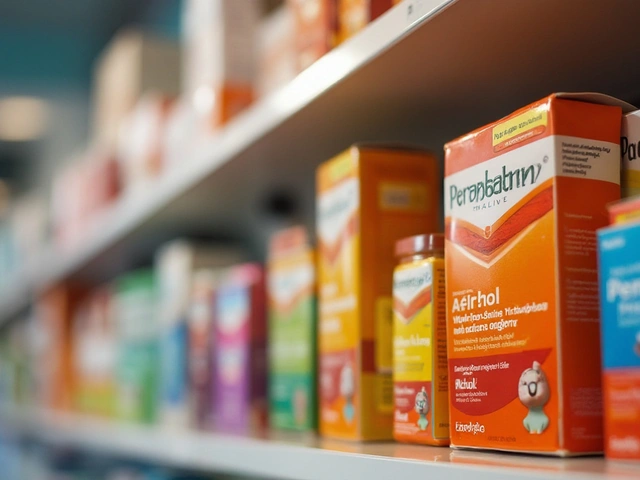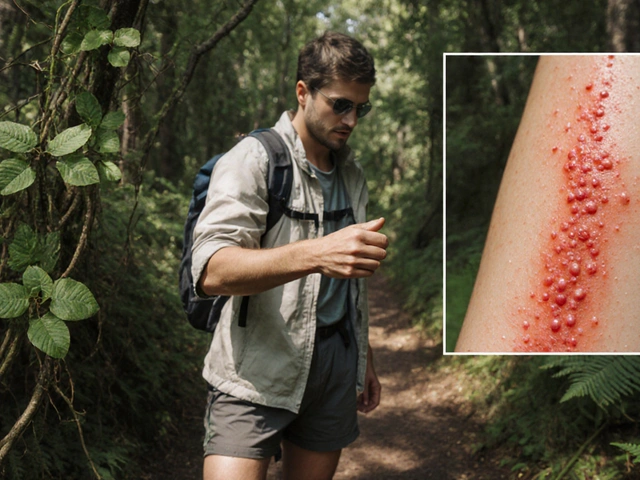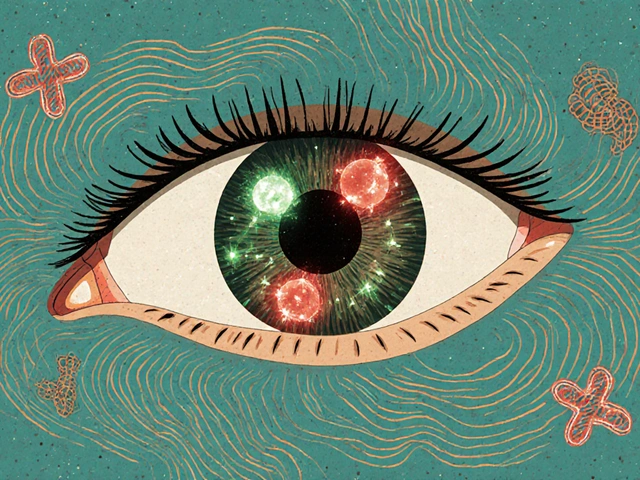Diaper rash that won’t go away, no matter how often you change the diaper or how much zinc oxide cream you use? It might not be just friction or moisture-it could be your baby’s food. When a baby develops a persistent, bright red rash that looks angry and spreads beyond the usual diaper area, especially after introducing new foods, food allergies are often the hidden cause. Unlike typical diaper rash, this one doesn’t respond to standard creams. It flares up after meals and sometimes comes with other signs like loose stools, vomiting, or fussiness. Treating it isn’t about better barrier creams-it’s about finding and removing the trigger.
What Does an Allergic Diaper Rash Look Like?
An allergic diaper rash looks different from a regular one. Instead of a mild pinkness or small patches, it’s often a deep red, raised, and sometimes bumpy rash that spreads to the thighs, belly, or even the buttocks. The skin might look scaly, cracked, or weepy. It doesn’t improve with frequent diaper changes or over-the-counter ointments. You’ll often see it appear within hours after your baby eats something new-like cow’s milk, eggs, soy, wheat, or citrus fruits. If your baby is breastfeeding, the allergen might be hiding in your diet. Common triggers include dairy, soy, nuts, eggs, and tomatoes.
Why Food Causes Diaper Rash
When a baby is allergic to a food, their immune system treats it like an invader. The body releases histamine and other chemicals, which increase blood flow and inflammation. That’s why the skin gets red and itchy. But why the diaper area? Because the digestive tract and skin are closely linked. Undigested food proteins pass through the gut, enter the bloodstream, and end up in the stool. When that stool hits the baby’s sensitive skin, the leftover proteins irritate it directly. The acidic nature of the stool from an allergic reaction makes the rash worse. It’s not the diaper itself-it’s what’s in the poop.
Step-by-Step: How to Treat It
- Stop using regular rash creams as your first line of defense. Zinc oxide helps with irritation, but it won’t fix an allergic reaction. If the rash keeps coming back, you’re treating the symptom, not the cause.
- Keep a food and rash journal. Write down every food your baby eats, when they eat it, and when the rash flares up. Do this for at least 7-10 days. Note even small amounts-like a spoonful of yogurt or a bite of apple. Look for patterns. If the rash appears every time your baby has dairy, that’s a clue.
- Eliminate the top suspects. Start by removing the most common allergens: cow’s milk, soy, eggs, wheat, peanuts, and citrus. If you’re breastfeeding, cut those out of your diet too. Don’t guess-remove them all at once. Wait 10-14 days. If the rash clears up, you’ve found your trigger.
- Reintroduce foods one at a time. Once the rash is gone, add back one food every 3-4 days. Watch closely for any return of redness, swelling, or changes in stool. If the rash comes back after adding back milk, you’ve confirmed the allergy. Don’t rush this step.
- Switch to hypoallergenic formula if needed. If your baby is on formula and you suspect an allergy, talk to your pediatrician about switching to an extensively hydrolyzed formula (like Alimentum or Nutramigen) or an amino acid-based formula (like Elecare). These are designed for babies with food allergies. Don’t switch to soy formula without checking-it’s often not safe if the baby is allergic to soy.
- Use gentle, fragrance-free skin care. Wash the diaper area with warm water and a soft cloth. Avoid wipes with alcohol, fragrance, or parabens. Pat dry-don’t rub. Let the skin air out for 10-15 minutes before putting on a fresh diaper. Use a thin layer of barrier cream with zinc oxide or petroleum jelly only after the rash has started to heal, not as a cure.

What Not to Do
Don’t use steroid creams unless a doctor prescribes them. They can thin the skin and mask symptoms without fixing the root problem. Don’t try home remedies like cornstarch or baking soda baths-they can trap moisture and make fungal infections worse. Don’t ignore other symptoms. If your baby has vomiting, blood in stool, poor weight gain, or breathing trouble, seek medical help immediately. These aren’t just diaper rash signs-they could mean a serious allergic reaction.
When to See a Doctor
See your pediatrician if:
- The rash lasts more than 7 days despite changes in diet and care
- The skin is broken, oozing, or has yellow crusts (signs of infection)
- Your baby has diarrhea with blood or mucus
- They’re not gaining weight or seem unusually fussy after eating
- You suspect multiple food allergies
A doctor can order a skin prick test or blood test to confirm allergies. They can also rule out yeast infections (candida), which often look similar and thrive in the warm, moist environment created by acidic stool from food allergies.

Long-Term Management
Many babies outgrow food allergies by age 3 or 4. But until then, avoiding the trigger is the only way to prevent rashes. Keep a list of safe foods and unsafe foods handy. When introducing new foods, do it slowly-one at a time, every few days. Always check labels on baby food, snacks, and even medicines. Some contain hidden dairy, soy, or wheat. If you’re breastfeeding, keep eating a varied diet unless you’ve confirmed a specific trigger. You don’t need to eliminate everything unless your baby reacts.
Some parents find that probiotics help reduce gut inflammation and improve skin health. While not a cure, strains like Lactobacillus rhamnosus GG have been shown in studies to reduce eczema and allergic reactions in infants. Talk to your doctor before starting any supplement.
Real-Life Example
A mother in Wellington noticed her 8-month-old’s rash kept returning after every bottle of formula. She switched brands, changed diapers hourly, and used every cream on the shelf. Nothing worked. She started a food journal and realized the rash flared every time her baby had cow’s milk formula. After switching to a hydrolyzed formula, the rash faded in 5 days. She later found out her baby was allergic to cow’s milk protein-a common issue affecting about 2-7% of infants. With the right formula and careful food tracking, the baby grew out of it by age 2.
Preventing Future Flare-Ups
Once you’ve identified the trigger, avoid it completely. But don’t assume your baby will always be allergic. Reintroduce the food every 6-12 months under medical supervision. Many children outgrow milk, egg, or soy allergies by school age. Keep your pediatrician in the loop. They can guide you through oral food challenges when the time is right.
Remember: diaper rash from food allergies is not your fault. It’s not caused by poor hygiene or bad parenting. It’s a biological response your baby’s body is having to something they can’t yet tolerate. The goal isn’t to stop all new foods-it’s to find the ones that cause trouble and avoid them until your baby’s system is ready.
Can breastfeeding cause diaper rash from food allergies?
Yes. Proteins from foods you eat can pass into your breast milk and trigger an allergic reaction in your baby. Common culprits include dairy, soy, eggs, nuts, and wheat. If your baby has a persistent diaper rash and you’re breastfeeding, eliminating those foods from your diet for 2-3 weeks may help. Track changes in the rash and your baby’s stool. Reintroduce foods one at a time to find the trigger.
Is diaper rash from food allergies the same as a yeast infection?
No. A yeast infection (candida) often looks like a bright red rash with small red dots around the edges. It usually doesn’t improve with regular diaper rash creams and can be accompanied by thrush in the mouth. Food allergy rashes are more widespread, often with a scaly or raised texture, and flare up after eating specific foods. A doctor can take a swab to confirm if it’s yeast. Sometimes both happen together-especially if the skin is broken from an allergic reaction.
How long does it take for a food allergy rash to go away?
Once you remove the trigger, most food-related diaper rashes start improving within 2-3 days. Full healing can take up to 10-14 days, especially if the skin was badly irritated. If there’s no improvement after two weeks of avoiding the suspected food, check for other causes like yeast, bacterial infection, or a different allergen.
Can I use cloth diapers if my baby has a food allergy rash?
Yes, but only if you wash them properly. Use fragrance-free, hypoallergenic detergent and rinse twice to remove all soap residue. Fabric softeners and dryer sheets can irritate sensitive skin. Some parents find that disposable diapers with fewer chemicals work better during flare-ups. The key isn’t the diaper type-it’s keeping the skin clean, dry, and free from allergens in stool.
Are there any foods that commonly cause diaper rash in babies?
Yes. The most common offenders are cow’s milk, soy, eggs, wheat, peanuts, tree nuts, citrus fruits, tomatoes, and chocolate. These foods are either highly acidic or contain proteins that trigger immune responses in sensitive babies. Introduce them one at a time after 6 months and watch for rashes, diarrhea, or vomiting. If your baby reacts, wait until they’re older before trying again.






Evan Brady
November 19, 2025 AT 02:18Been there. My son had a rash that looked like a damn war zone-bright red, spreading to his thighs, didn’t care how many times I changed him. Zinc oxide? Useless. Then I cut out dairy from my breast milk (yes, I was nursing) and within 72 hours, it was like someone flipped a switch. The skin healed, the fussiness stopped. Seriously, if your diaper rash won’t quit, look at what’s in the poop, not the diaper.
Food allergies aren’t just about hives or vomiting. Sometimes, they’re just a screaming baby with a butt that looks like it got into a jalapeño fight.
Brandon Lowi
November 19, 2025 AT 12:59Ohhhhh, so this is what happens when you let the globalist baby-food conglomerates brainwash you into thinking ‘organic’ means ‘safe’?!!!
Look-I’m an American, and I raised three kids without ever reading a single study. We fed them milk, eggs, wheat, and yes-orange juice before breakfast. No rash. No drama. Just strong bones and louder cries. You want to know what causes diaper rash? Not food. It’s the damn ‘hypoallergenic’ wipes they sell you at Whole Foods. Those things are laced with chemicals from the New World Order. Cut the fancy journals. Go back to water and a washcloth. That’s what my grandpa did. And he fought in WWII.
Also-why are you all so scared of food? Are we raising babies or lab rats?!
Jenny Lee
November 20, 2025 AT 20:40My daughter’s rash cleared up in 48 hours after I dropped soy. No drama. No tears. Just a happy baby and a clean butt. Sometimes the fix is that simple.
Ram tech
November 22, 2025 AT 06:21man i just use baby powder and call it a day. why overthink? its just a rash. also why u so worried bout food? baby eat stuff, baby poop, baby cry. normal.
Jeff Hakojarvi
November 22, 2025 AT 21:38Just want to say-this post saved my sanity. I was so overwhelmed, blaming myself for not changing diapers fast enough. Turns out, it was the oatmeal I introduced last week. I cut it out, used warm water only for a few days, and the rash started fading within 36 hours. I’m not a doctor, but if you’re reading this and your baby’s rash won’t quit-don’t give up. Keep the journal. It’s tedious, but it works.
And yes, you’re not a bad parent. This isn’t your fault. You’re doing better than you think.
Timothy Uchechukwu
November 24, 2025 AT 13:50Why do you think the government allows this? They know food allergies are a scam to sell more formula and tests. Look at the statistics-every time a new study comes out, the price of hypoallergenic formula goes up. Coincidence? I think not. Your baby’s rash? Probably just too many diapers. Let the skin breathe. Let the child suffer a little. Builds character. And stop buying into the medical-industrial complex.
Also-why are you feeding your baby fruits? Fruit is for adults. Babies should eat rice and water. That’s what nature intended.
Ancel Fortuin
November 25, 2025 AT 08:52Oh wow. So the real cause of diaper rash is… *gasp*… the same thing Big Pharma doesn’t want you to know? I mean, what’s next? The moon landing was faked and your baby’s poop is secretly a surveillance tool? I’m not saying it’s true-but have you checked if the formula has microchips? I read on a forum that if the rash appears after 2pm, it’s definitely the GMO corn syrup in the milk.
Also, I’m 97% sure the CDC is behind this. They’re testing how long it takes moms to crack under guilt. You’re being watched.
Hannah Blower
November 26, 2025 AT 22:23Let’s be honest: this entire post is just a beautifully curated symptom checklist disguised as medical advice. You’re not treating an allergy-you’re performing a performative ritual of maternal guilt. Every parent who reads this will now obsess over every spoonful of banana like it’s a forensic crime scene. The real problem? The cultural expectation that mothers must be allergen-detective ninjas. Meanwhile, the pediatrician’s office is cashing in on IgE tests priced at $400 a pop.
And let’s not forget: you’re probably feeding your baby store-bought purees with hidden soy lecithin. The real villain? Industrial baby food. Not the food itself. The system.
Gregory Gonzalez
November 27, 2025 AT 05:10How quaint. A 12-step program for diaper rash. I suppose next you’ll be recommending a 10-day meditation retreat for colic. Look-I get it. You want to feel in control. But let’s not pretend this is science. It’s anecdote wrapped in bullet points and sold as gospel. If your baby’s rash doesn’t clear up after eliminating dairy, you’re not a bad parent-you’re just bad at statistics. Maybe try… I don’t know… a dermatologist? Or perhaps, the radical concept of ‘wait and see’? The world didn’t end when we fed our kids peanut butter in the ‘90s.
Ronald Stenger
November 28, 2025 AT 20:15Let me get this straight-you’re telling me that after centuries of human evolution, our babies suddenly started getting diaper rashes because we introduced cow’s milk? That’s the most un-American thing I’ve heard since the FDA approved kale smoothies for toddlers. Back in my day, we used cloth diapers, boiled water, and a slap on the butt. No journals. No elimination diets. Just discipline. And guess what? We didn’t have a single kid with a ‘food allergy rash’-because we didn’t have the luxury of overthinking every bite.
Also, who gave you the right to say ‘it’s not your fault’? It’s always your fault. You’re the parent. Act like it.
Samkelo Bodwana
November 30, 2025 AT 04:29I’ve been thinking about this a lot, and I think we’re missing the bigger picture. Diaper rash from food allergies isn’t just about the baby-it’s about the entire ecosystem of modern parenting. We’ve created this culture where every bodily function is analyzed, every reaction is pathologized, and every parent is made to feel like they’re failing if their child has one red spot. I’ve seen moms cry because their baby had a rash after eating avocado. But here’s the thing-our ancestors didn’t have food journals or hydrolyzed formulas. They had community. They had grandmothers who just said, ‘Let it be. It’ll pass.’
Maybe the real solution isn’t eliminating dairy, but eliminating the pressure to be perfect. Maybe the rash is just a signal-not a crisis. Maybe we need to trust our bodies, our babies, and our intuition more than we trust the latest blog post with 12 bullet points.
I’m not saying ignore medical advice. I’m saying: don’t let fear replace wisdom. And for heaven’s sake, let your baby’s skin breathe. Let them lie on the floor without a diaper for 10 minutes. Just once a day. It helps. More than you think.
Evan Brady
November 30, 2025 AT 18:38Samkelo, you just summed up everything I’ve been feeling but couldn’t articulate. I stopped the journal after two weeks. I didn’t find a trigger. But I started letting my baby nap without a diaper. Just on a towel. And I stopped apologizing for every little red spot. The rash didn’t vanish overnight-but my anxiety did. Turns out, the most powerful treatment wasn’t in the fridge. It was in the quiet.